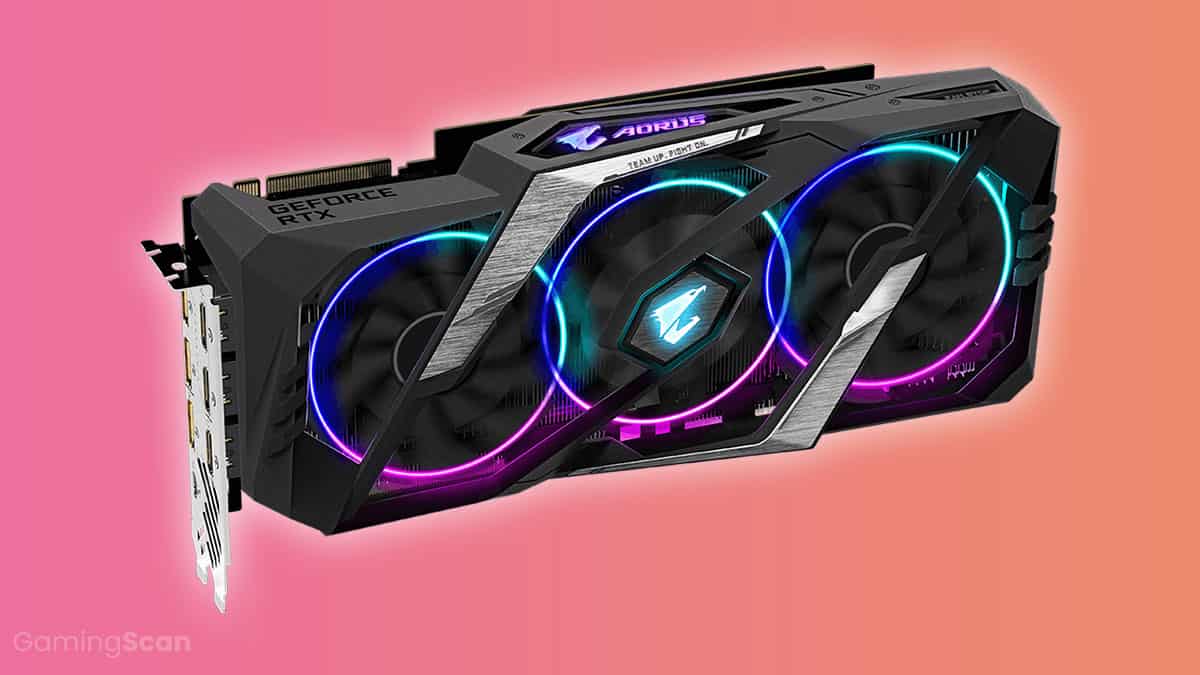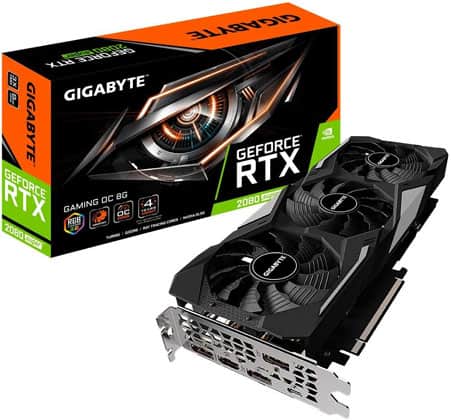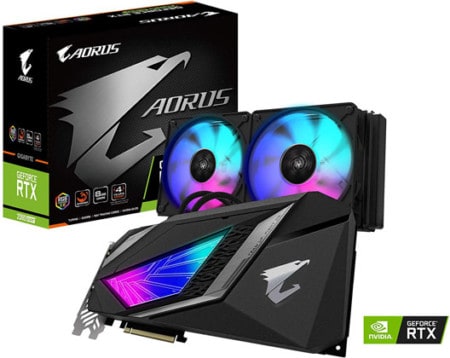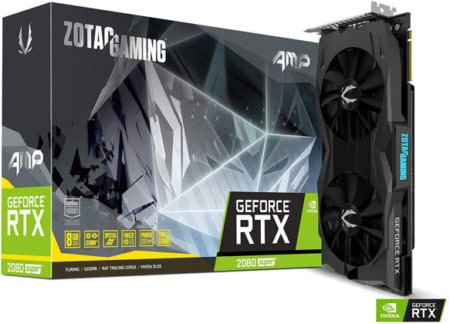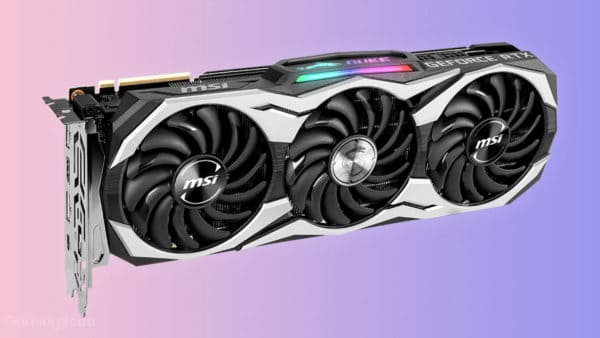If you’re building a high-end PC in 2023 and are looking for a GPU that can provide good 4K and 1440p performance without being prohibitively expensive like the RTX 2080 Ti, then the RTX 2080 Super would likely be the best pick for your needs.
This GPU launched in July 2019, almost a year after the original RTX 2080, keeping all the main elements that its predecessor had while also presenting a performance boost. Granted, it is not a major upgrade, but the little bit of extra performance that you would get with an overclocked RTX 2080 Super could very well smooth out your gameplay experience.
But which RTX 2080 Super should you pick?
There are quite a few RTX 2080 Super graphics cards available, and comparing them with one another in order to find the one that suits your needs best could be a time-consuming effort.
So, if you’d like to see the absolutely best RTX 2080 Super models right now, continue reading!
Table of ContentsShow
ZOTAC GAMING GeForce RTX 2080 SUPER AMP
Cooling: Dual-fan
Boost Clock: 1845 MHz
Connectors: 3x DP, 1x HDMI
The Pros:
- Sleek and thin
- Cheaper than most models
The Cons:
- Not the best cooling
- Little room for overclocking
- No USB-C port
First up, we have the ZOTAC GAMING GeForce RTX 2080 SUPER AMP, a dual-fan card with a simple black shroud and a dual-slot design, complete with a backplate and some basic RGB in the form of a lit logo on the side. It is thin and sleek, especially for a high-end GPU such as the RTX 2080 Super, so it looks really good.
However, you’re not purchasing a GPU this powerful just for the design – so how is the performance? Well, with its two fans and a fairly slim cooler, the temperature and noise generation can get quite high. You can expect the card to hit about 75 degrees Celsius under full load, so as you might expect, there’s not much overclocking headroom to speak of.
What this particular RTX 2080 Super model has going for it is that it’s among the more affordable models currently available. Granted, if you’re already spending this much on a GPU, chances are you’d be willing to dish out a few more bucks for a version with better cooling, but we feel that this model is worth mentioning nonetheless.
EVGA GeForce RTX 2080 Super
Cooling: Blower
Boost Clock: 1815 MHz
Connectors: 2x DP, 1x HDMI, 1x USB-C
The Pros:
- Solid blower cooler
- Good for cramped cases
The Cons:
- Can get hot and loud under load
- Limited overclocking
The next model comes from EVGA, and it is a blower-cooled variant of the RTX 2080 Super. We feel that blower-equipped cards often look quite good, and that is definitely the case with this model, which boasts a partially-translucent shroud.
But as you might know, blowers don’t usually offer the best cooling efficiency, especially not for a card this powerful. So, much like the previous model from Zotac, it will be running quite loud and hot, and it’s definitely not the card you should pick if you care about overclocking the GPU.
That said, the reason we are including this card on the list is that blowers can be good solutions for smaller, more cramped cases with limited airflow, as they blow hot air directly out the back of the card, thus preventing heat buildup inside the case.
Gigabyte GeForce RTX 2080 Super Gaming
Cooling: Triple-fan
Boost Clock: 1845 MHz
Connectors: 3x DP, 1x HDMI, 1x USB-C
The Pros:
- Solid overall performance
- Neutral exterior design
The Cons:
- Limited RGB
Moving on, we get to some more serious solutions for 4K gaming, starting with the Gigabyte GeForce RTX 2080 Super Gaming. Like with the previous Gaming series Turing GPUs, the company dropped the orange highlights that have seen often in their earlier cards, featuring a simple black shroud with some gray highlights – an effective design that is very nicely complemented by the striped fans.
While it is by no means the best cooling solution currently available, the triple Windforce fans do a good job at keeping the card cool, and it generally won’t exceed 65 degrees Celsius under load – a big step forward in efficiency compared to the sort of heat and noise generated by the above two models.
Now, this RTX 2080 Super model from Gigabyte is a tad pricier, so we would have liked seeing some more extensive RGB lighting thrown into the mix for good measure, as the card only features an RGB-lit logo on the side, which is a bit disappointing at this price point.
MSI GeForce RTX 2080 Super Gaming X Trio
Cooling: Triple-fan
Boost Clock: 1845 MHz
Connectors: 3x DP, 1x HDMI, 1x USB-C
The Pros:
- Solid performance
- Appealing shroud and backplate design
- Beautiful RGB lighting
The Cons:
- Runs a bit hotter than the Gigabyte variant
Next, we have a similar solution to the above Gigabyte model coming from MSI – the MSI GeForce RTX 2080 Super Gaming X Trio.
Much like Gigabyte, MSI implemented a new and improved design with the first generation of Turing models – the gaudy red highlights are gone and are now replaced by a more neutral black shroud that is complemented by a brushed metal backplate, which is a very nice combo. Moreover, you’ll notice the extensive RGB lighting that makes for a great way to add some color to your build.
As far as the performance is concerned, the Gaming X Trio is on fairly even terms with Gigabyte’s card, albeit it runs a bit hotter and a bit quieter, so it takes one step forward and one step back when it comes to the cooling. Regardless, you’re unlikely to notice the difference in performance.
Essentially, if you want a card that performs about as well as the Gigabyte RTX 2080 Super but are willing to pay a little bit extra for the added RGB lighting, then the MSI RTX 2080 Super Gaming X Trio would be a good fit for your needs.
ASUS ROG Strix GeForce RTX 2080 Super
Cooling: Triple-fan
Boost Clock: 1860 MHz
Connectors: 2x DP, 2x HDMI, 1x USB-C
The Pros:
- Balanced performance
- Quality RGB
The Cons:
- Design could use a refresh
- On the pricey side
If you want to have both RGB lighting and good performance, then the ASUS ROG Strix GeForce RTX 2080 Super might be a better fit for your needs than either of the prior two models.
Asus always offered very good cooling with its ROG Strix models, and one would expect nothing less from this brand. That said, the card has a higher factory clock than the MSI Gaming X Trio and it can hit similar maximum clock speeds, all the while being on the Gigabyte model’s level when it comes to the temperatures and noise.
Now, as mentioned above, Asus’ ROG Strix RTX 2080 Super does have RGB lighting, although you might notice that they’re still using the same shroud and backplate design that they’ve been using since 2016, so it looks a bit dated compared to most other 2023 models, especially in this price range.
EVGA GeForce RTX 2080 Super FTW3 Ultra
Cooling: Triple-fan
Boost Clock: 1845 MHz
Connectors: 3x DP, 1x HDMI, 1x USB-C
The Pros:
- Good, balanced performance
- RGB works great with translucent shroud
The Cons:
- High price
- Bulky cooler
The following card that we have lined up is another solution from EVGA, albeit it is a much more serious performance-oriented solution – the EVGA GeForce RTX 2080 Super FTW3 Ultra.
This series of EVGA cards always consisted of some of their best air-cooled models, something that you can tell at first glance at the three fans and the massive heatsink.
As far as raw performance is concerned, the FTW3 Ultra is almost identical to the Asus ROG Strix version of the RTX 2080 Super, as the two cards offer similar cooling efficiency, similar noise levels, similar maximum clock speeds, and they come with the same price tag attached.
That said, the main difference lies in the design. While we don’t much like EVGA’s translucent shroud design in their cheaper cards that come without RGB, you can imagine how well it works here with customizable lighting. On the downside, much like the Asus variant, it is fairly pricey, plus not everyone will like the card’s bulky 2.75 slot design.
Gigabyte AORUS GeForce RTX 2080 Super Waterforce
Cooling: Liquid
Boost Clock: 1860 MHz
Connectors: 3x DP, 3x HDMI, 1x USB-C
Now, if you really want to squeeze the most performance that you can out of an RTX 2080 Super, you’ll want to go with a liquid cooler. And so, we have decided to add the Gigabyte AORUS GeForce RTX 2080 Super Waterforce card to the list.
As you can tell from the picture, Gigabyte AORUS cards usually feature the kind of design and RGB lighting that puts Asus’ ROG models to shame, which is saying something. Granted, not everyone will be a fan of such angular and somewhat over-the-top design approach, but it is what it is.
Enough about the design, though – how about the cooling?
Well, the card ships with an AIO liquid cooler, complete with a pump, a waterblock, and a single 240mm case-mounted radiator which is cooled by two 120mm fans. With this cooler, you can push the card even further than what air cooling allows, all the while it will be running at noticeably lower temperatures.
However, liquid cooling is fairly expensive, and the boost in performance that you’d get out of a liquid cooler such as this one might not be worth the extra expense for everyone.
Gigabyte AORUS GeForce RTX 2080 Super Waterforce WB
Cooling: Liquid
Boost Clock: 1860 MHz
Connectors: 3x DP, 3x HDMI, 1x USB-C
The Pros:
- Very sleek exterior
- Stunning RGB
The Cons:
- Expensive
- Dubious value
And for the final entry, we have the Gigabyte AORUS GeForce RTX 2080 Super Waterforce WB, which is a version of the RTX 2080 Super that comes only with the waterblock pre-installed.
What this means is that you’ll need to get a pump, a radiator, and fans separately. That said, you could build a custom loop, which would allow for more customization, or you could just get a third-party AIO liquid cooler.
You’ll notice that the waterblock-only variant looks much thinner and sleeker, but the problem is that it costs as much as the regular RTX 2080 Super Waterforce card that comes complete with the AIO cooler. That said, seeing as you’d have to get all the other parts separately, there’s a fair amount of extra spending involved.
How To Pick The Right Card For Your Needs
Now that we have gone over our selection of the best RTX 2080 Super models available at the moment, what are some things that you need to keep in mind when selecting a GPU?
Size

When compatibility is concerned, one of the main factors to consider (especially when it comes to bulky high-end graphics cards) is the physical size of the card. If you want to make sure that the card you’re getting can fit inside your case, the two key dimensions to keep in mind are length and width.
Some graphics cards are longer than others, be it due to a longer PCB or a longer cooler that extends past the PCB. In either case, you should always make sure that the card won’t be obstructed by the HDD/SSD rack.
As for width, some cards take up more vertical space inside the case due to having a bulkier cooler, usually due to a thicker heatsink. This can lead to two potential issues:
- They might obstruct some of the PCIe slots on the motherboard, thus preventing you from installing any additional PCIe expansion cards in those slots.
- They might be too close to the bottom of the case, and even if there is enough room to fit the card, being too close to the bottom or a bottom-mounted power supply could inhibit the cooler’s air intake, thus leading to higher temperatures and higher noise generation.
As mentioned above, most high-end graphics cards are quite big, and the RTX 2080 Super – one of the most powerful graphics cards available at the moment – is obviously no exception. As such, it would be a good idea to check the dimensions of the card you’re getting, as well as the dimensions of your case i.e., the case that you plan on getting in the future.
Cooling
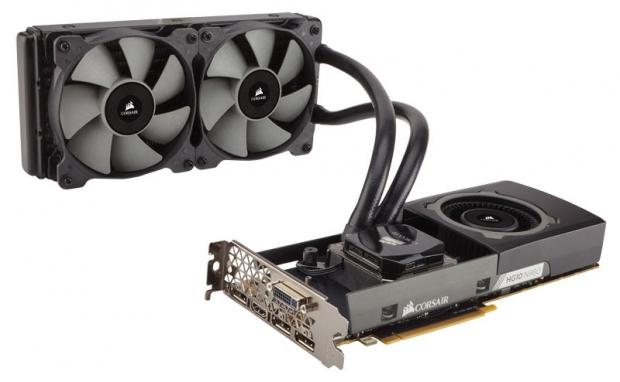
The graphics card is where most of the heat generated by your PC comes from, and like any other component that generates a lot of heat, it needs active cooling. As you can tell from the article, modern GPU often utilize one of the three following types of cooling:
- Open-air
- Blower
- Liquid
Open-air coolers are the most common, and most of the graphics cards currently listed in this article utilize them. For the most part, open-air coolers are the best option for the greater number of gaming PCs because they include good heat dissipation overall and can benefit more from case fans. These coolers can utilize anywhere from one to three fans, but in the case of high-end cards such as the RTX 2080 Super, they most commonly come with three.
As for blowers, they contrast open-air coolers in that they feature a closed heatsink and a single blower fan that blows the hot air out of the back of the card, directly out of the case. This prevents heat buildup inside the case, which makes the blower good for smaller cases with limited airflow.
Finally, liquid cooling is the most efficient cooling method by far, which makes it ideal for overclocking. Liquid-cooled GPUs can hit higher clock speeds, all the while running at noticeably lower temperatures than their air-cooled counterparts. However, they are not necessarily quieter, as they still need a pump to cycle the liquid and fans to be able to cool the radiator.
Moreover, liquid coolers are often really expensive, and can easily add over $100 to the price of a graphics card. Moreover, while they are more efficient, the actual in-game performance boost that one can get through overclocking still isn’t that much better than what’s possible with an air cooler.
As such, the main upsides of a liquid cooler in a GPU are the aesthetics and the lower temperatures, potentially also lower noise generation if it’s a high-quality pump and fans we’re talking about. That said, liquid-cooled GPUs are mostly the enthusiast’s game, and they might not be worth the extra expense if you don’t much care for tweaking your hardware settings or customizing your build.
Overclocking

Now that we have touched upon cooling, we have to say a couple of words about overclocking. In case you’re not familiar with it, overclocking is the act of pushing a GPU’s clock speed beyond the default clock speed set by the manufacturer.
Now, the RTX 2080 Super is a potent GPU, so how much extra performance can you squeeze out of it through overclocking?
Well, generally speaking, an overclocked GPU can get you roughly 5-15% more frames per second compared to a card running with reference settings, but this will inevitably vary from game to game.
In the case of weaker mid-range or budget GPUs, this is a mostly-negligible boost. However, when it comes to a card such as this one that can handle 4K, such an increase could translate into a decent chunk of FPS that could smooth out your gaming experience.
In any case, the kind of performance offered by all the models here is relatively similar, and the differences in temperature and noise generation are more noticeable than the difference in in-game performance, which usually ends up being only a couple of frames.
Aesthetics
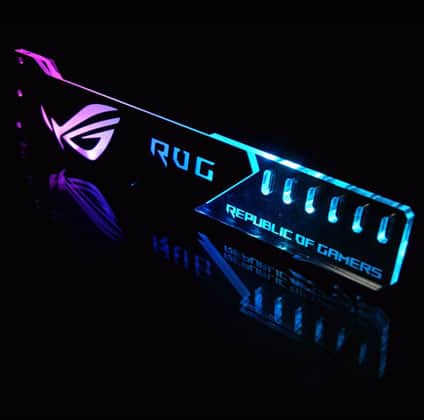
You’ve probably noticed that we talked about the card design a lot in the article. And sure enough, aesthetics are more important than ever, what with the rising popularity of translucent cases and RGB lighting. As a result, the OEMs are trying harder than ever before to make their cards visually appealing, both because of that and because a better-looking card makes for a more marketable product.
So, if you’re getting a see-through case or are building an open rig and want to make sure your setup looks good, what should you keep in mind when it comes to your future graphics card’s design?
First and most, we have color. Only a few years back, many graphics cards had specific color highlights that served as something of a manufacturer’s signature. For example, Gigabyte had orange, Zotac had yellow, and MSI had red, although the design varied from series to series.
However, most OEMs have moved away from this design approach, and for two reasons: consistency and RGB lighting.
Naturally, for it to look aesthetically pleasing, a build must have a consistent color scheme, and by painting their shrouds and backplates a specific color, OEMs made it more difficult for their cards to blend in with different setups. Now, cards mainly have black shrouds with more subtle gray or white highlights, something that makes them more neutral.
Then, there’s the RGB lighting, which is a better solution on virtually every front if you want to add some color to your setup. It is flexible and allows you to easily establish and change the color scheme across different components whenever you feel like it, not to mention that it is cheaper than ever and is now quite commonplace even among the more affordable graphics cards.
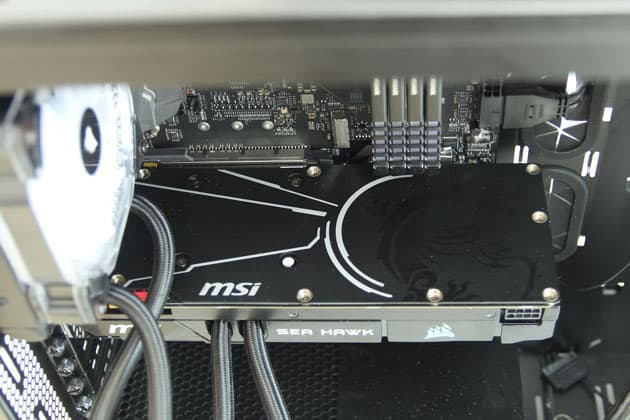
Finally, there’s the backplate. Much like RGB, backplates are slowly making their way to the lower price ranges, and in 2023, it’s not uncommon to find them even in budget graphics cards such as the GTX 1650 Super.
Most can agree that backplates look awesome, but what purpose do they serve?
Well, the main purpose of a backplate is just that – they look cool. In practical terms, however, they do protect the PCB, preventing it from bending, and they also make it easier to get the dust off the back of the card, which is always convenient.
Something that a backplate does not do, however, is aid with the cooling. Despite what some OEMs might claim, tests have shown that having a metal backplate doesn’t help with heat dissipation at all, so graphics cards with backplates won’t be hitting higher clock speeds or running any cooler than their backplate-less counterparts.
Connectors

Something that differs from model to model is the type and number of connectors that the card comes with, so what connectors are there, and which should you prioritize?
In 2023, the latest graphics cards come with two primary connectors: DisplayPort 1.4 and HDMI 2.0. And how do these two compare?
Well, in this context, the two most important things to keep in mind are the resolutions and the refresh rates.
HDMI 2.0 supports 4K in 60 Hz and 1080p in 120 Hz. Meanwhile, DisplayPort 1.4 supports 8K in 60 Hz, 4K in 120 Hz, and 1080p at 240 Hz. Both of these connectors support HDR, both can transfer audio, although when it comes to adaptive sync, HDMI only supports AMD FreeSync whereas DisplayPort supports both AMD FreeSync and Nvidia G-Sync.
DisplayPort is generally a more popular solution for monitors, but whether you really need the higher data throughput that this connector allows depends entirely on your monitor’s resolution and refresh rate, as well as if it supports G-Sync.
Keep in mind – it is important to make sure that your monitor is using the same version of DisplayPort/HDMI as the graphics card! Both HDMI and DisplayPort are backward compatible, but if the graphics card comes equipped with DisplayPort 1.4 and HDMI 2.0 but your monitor uses an older version of these technologies such as DisplayPort 1.2 or HDMI 1.4, you could end up missing out on some features or you would be dealing with a potentially problematic resolution/refresh rate limit.
Conclusion – The Best RTX 2080 Super For 2023
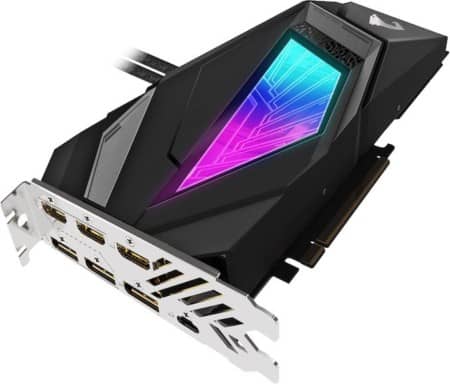
So, at the end of the day, which of these models would we choose?
Well, as you can tell, there is no one-size-fits-all solution with graphics cards, as they all have their pros and cons. If we had to pick, we’d go with the EVGA GeForce RTX 2080 Super FTW3 Ultra as our main choice, since we feel that it finds the best balance between performance, cooling efficiency, noise generation, aesthetics, and pricing.
If you’re struggling to make the RTX 2080 Super fit your budget, then the first Zotac model might be worth it, though we feel that the Gigabyte GeForce RTX 2080 Super offers the best value for your money if you can’t quite afford to go all-out with some of the pricier models.
And for the premium pick, the Gigabyte AORUS GeForce RTX 2080 Super Waterforce is the evident choice here, as it allows for some extra overclocking headroom, it runs cool, looks great, and the noise generation is good for a setup with a pump and two fans.
Ultimately, an RTX 2080 Super is an RTX 2080 Super, and any of the cards listed here would make for good picks, provided that you keep your requirements and budget, as well as the cards’ pros and cons in mind.
On a final note, if you’re constructing an entire PC from scratch, you might want to take a look at our configuration that features the RTX 2080 Super and costs just under $1500.
